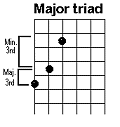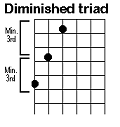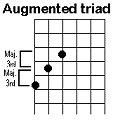Triads
The simplest chords are triads. As you might gather from the name, there are three notes in a triad. You need at least three notes to form a chord.
| The first form is the major triad. This consists of a root, and the third and fifth degrees above the root. (eg. C E G, A C# E). This can also be looked upon as a major third (whole step, whole step) plus a minor third (whole step, half step). |  | The second form is the minor triad. This is like the major triad, except for a flatted third. (eg. C Eb,G, A C E). This can also be looked at as a minor third plus a major third. |  |
| Another form is the diminished triad. In this case both the third and the fifth are flatted. (eg. C Eb Gb, A C Eb). This is a minor third plus a minor third. |  |
| The augmented triad is like the major triad, except the fifth is sharped. (eg. C E G#, A C# E#). This is a major third plus a major third. |  |
| Although there is no half step between E and F, it is not incorrect to call the fifth degree of A augmented E# rather than F. E# makes it more clear that this is an altered fifth. |
Practice these triad forms in various places around the neck. Name each note of each triad out loud to help you memorize the fretboard.
Okay, the previous section may seem pretty simple, and you may be saying "So what?" Well, now that we have some fundamentals of harmony under our belts, we're going to delve into "harmonic theory," the term that musicians use in an effort to make counting to thirteen sound like rocket science.
But for today, we're not even going to get to thirteen. Today we're here to get a glimmering about why songs consist of chord "progressions."
Just as the notes of a major scale follow a pattern of pitch intervals, so must chords and the notes within the chords if they are to lend to the tonality of a piece. In order to do this, the notes of the chords must be diatonic to the given key. Diatonic means "of the key."
Let's look once again at the key of C major, and pretend for a moment that this simple scale is a melody, and that we want to harmonize each note of the melody with a chord. At first you might think that you could just play the major triad with the root that corresponds to each note of the melody. While this sounds fine with each note of the melody taken separately, it gives no sense of a tonal "center." That's because not all the notes of each major triad are diatonic to the key of C. So what we need to do is a "diatonic harmonization" of the key of C.
The first note of our melody is C. Since all the notes of the C major triad are by definition part of the C major scale, we can harmonize this note with a C major triad. But the second note of our melody is. . . different . . .
The next note of our "melody" is D. The D major triad is D F# A. The third of this triad (F#) is not diatonic to C. The obvious fix is to flat the third, making this a D minor triad.
Here are the triads you need to play for a diatonic harmonization of the C major scale:
| CEG | DFA | EGB | FAC | GBD | ACE | BDF | CEG |
| maj. | min. | min. | maj. | maj. | min. | dim. | maj. |
| I | ii | iii | IV | V | vi | vii° | I |
All major scale harmonizations follow this pattern of major, minor and diminished triads. So, if you're playing a song in the key of C, and there's a chord with E as the root, it better be a minor chord.
Note the roman numerals under each chord above. These are to chords as degrees are to notes of a scale. That is, just as the tonic is always the first degree of a given scale, the I chord is always the major chord with the tonic as its root. The upper case roman numerals indicate a major chord, the lower case indicate a minor chord, and the little circle or "degree" sign means diminished. So we see that the ii, iii and vi are always minor chords, the vii° is always diminished, and the I, IV and V are always major.
Look at some songs you already know how to play, and analyze the chord structure bearing this diatonic harmonization stuff in mind. While you may find exceptions (usually turn-around chords or "out" passing chords), you will find most song structures follow this concept.
Copyright © 1995, Dennis W. Fohringer
